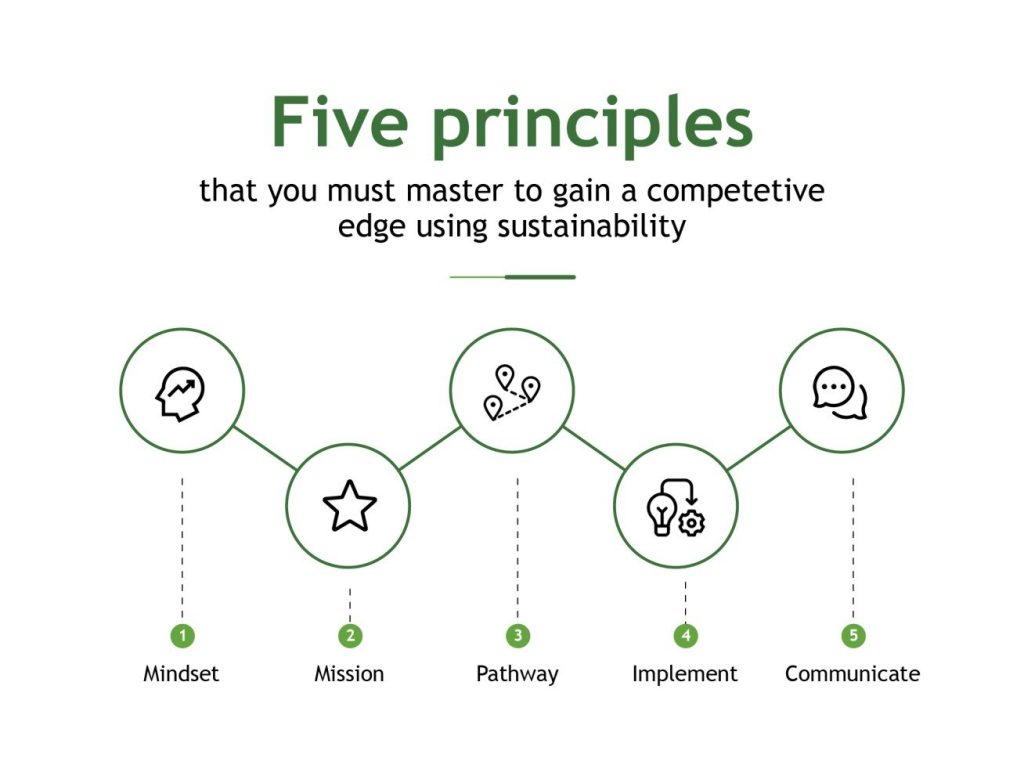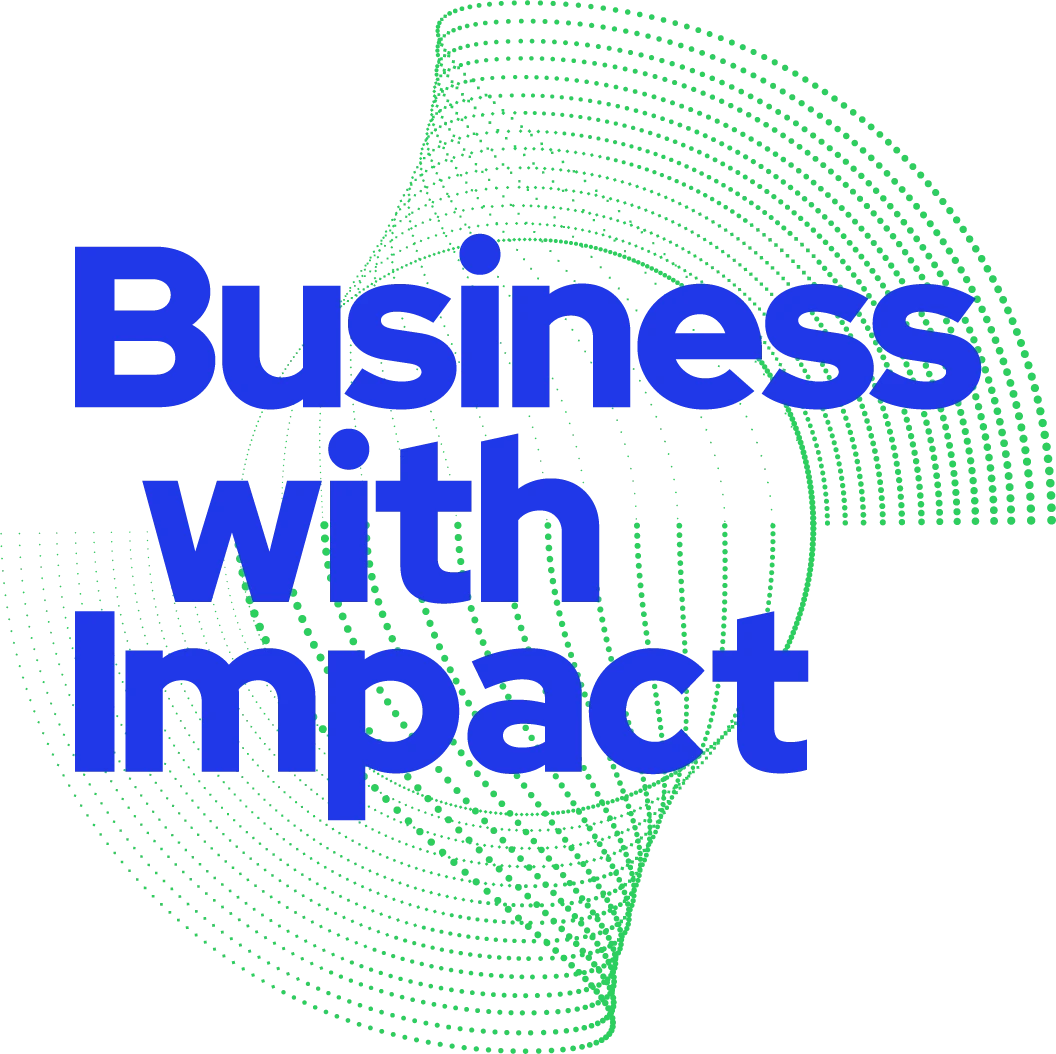Most companies today earn little or no ROI on their sustainability effort! And likewise, a low environmental impact. That is the sad truth and a key reason why business leaders shy away from stepping up their game, even though everybody can see we have to. But it does not have to be like that. Do it right, and there will be a goldmine awaiting.
When it comes to working with “green initiatives” businesses are doing all kinds of things, but there are relatively few that actually manage to get a really successful operation and significant impact out of it.
In this article, I will share an insight that has been 10+ years in the making. This is experienced-based insight. One that might very well make you want to change your strategy and goals. Let’s start with a graphical image to make it easier to visualize.

If you plot the environmental efforts of companies in terms of their business value and environmental impact, you will see something resembling an exponential curve. The problem is that the vast majority of companies will be in what I call the “Wilderness”. This is where your efforts only deliver a marginally positive impact on your business and the world. Recognize this situation? Don’t worry, you are not alone!
Right where the exponential curve really takes off is the interesting spot to be in. This is the bang-for-the-buck area to put it another way. You need slightly more effort – but applied differently to what you have previously been doing – and the value it generates is disproportional high.
You can see there is a red divider between the “Wilderness” and the “Sweetspot”. It marks a shift in approach and mindset rather than a massive increase in investment. Below you will see that there are five different areas or zones that companies fall into.
The five zones
The first one is the Danger zone. These are companies that are hardly doing anything when it comes to sustainability. It can be because it’s a startup that is just getting its act together, not yet sure where to focus or it’s one of those companies that still think that sustainability is not a significant pursuit. They’re doing the absolute minimum/nothing. It might even be a strategic decision to stay away from sustainability because they are targeting the shrinking group in the marketplace that shares that conviction that you’re not supposed to do anything about it. Leaving it to somebody else to take care of the problems. That’s the danger zone. If you read this, you are probably not here, and this group of companies is getting smaller and smaller. Move on or be rendered obsolete.
Then there is the Wilderness. This is where the vast proportion of companies can be found. In other words, it is the typical company that will be found here. They are carrying out different kinds of initiatives when it comes to sustainability, but very often it has a limited impact both in terms of business results and in terms of environmental results.
Most business leaders that are lost in the Wilderness find it really difficult to find a route out of it that is attractive or even doable. The good news is, that there is a recipe to follow if you want out. More on that in the last part of this article.
The main reason for being stuck here is due to the approach to working with sustainability. A few characteristics are:
- Sustainability is detached from the core strategy. It is something that a few people (or many depending on the size of the company) have as their responsibility. But that has no direct implications for the core business.
- The leadership team has little contact and engagement in the agenda
- Sustainability is a reductionists paradigm
- Goals are intrinsic in focus and at a limited level of ambition – i.e. can be reached “just” by implementing best practices.
Sure, the span is quite significant here. You can find companies at one end of the scale, on the left side of this curve, that are doing very little. Compliance is the name of the game. And then as you move to the right of the curve, you’ll find companies that are realizing some of the low-hanging fruits. We also find businesses that have introduced environmental management systems, and some are even certified (e.g. ISO 14001). But again, it’s not taken in and used as part of the strategy but run separately as a technical system to manage the sustainability initiatives and to be able to tell the world around that “we have systematized our effort and it has the same quality all the time”. Often, they already have other certification schemes like ISO 9001, so it is only needed an extra layer on the existing management system.
But as it is detached from the core business, it still means that the impact from an environmental perspective is relatively low and the feedback from the market is the same. And once a good idea emerges and is implemented it still has limited effect, as it is not tied to the core business. They do spend money on it, and in some cases even a significant amount of money but as the ROI is poor it just reinforces to the business leaders that there isn’t really a strong business case for sustainability. It’s mainly “a branding thing” and “the compliance thing”.
That is life in the Wilderness. This is where most companies are struggling along.
Then there’s the Sweetspot. This is where it becomes really interesting. As I said this is the bang-for-the-buck-area. When you position yourself in the sweet spot, you come from a different approach and it comes incredibly easier, more fun, and more rewarding. A few characteristics include:
- You are working with sustainability strategically with a focus on changing the way you operate, altering your core offering somehow.
- Leadership team is fully engaged and actively leads the way
- You have a clear mission, and you are clear and consistent in your messaging, and you take it to the marketplace. Consequently, you get rewarded for it.
I call it the Sweetspot because here you do enough to really make a difference and reap the benefits, but things are still relatively easy to manage. The complexity of the solutions is in the same ballpark as you are used to handling in other parts of your business. Your effort stands out from the crowd, so you attract more attention and deliver greater results.
The whole difference lies in the approach!
As you can see, I have drawn a divider between the Wilderness and the Sweetspot. It marks a shift in several parameters. From being “less bad” to being “more good”. From intrinsic focus to focus on something bigger. From a technical issue to a strategic business issue. From not attracting attention to becoming a magnet for attention and so on.
Companies to the right side of the red line are seen as part of the solution instead of part of the problem, so they start to get that “sustainability tailwind” that is actualized when you are doing it properly. People around you – customers, potential employees, and partners, can see where you want to go and find it appealing and meaningful, so they want to join in and be part of it. They want to be seen with you. They want to relate to you. They want to connect with you. You get a completely different return on investment on your effort.
This is where the effort/reward ratio peaks.
The Sweetspot is where I would recommend most of the well-established SMEs to aim. Because if you want to go even further up on the curve everything gets a lot more complex and requires significantly more investments on all levels. As I said earlier the Wilderness is populated by the majority of companies and therefore the potential is huge in making that upgrade. Both in terms of creating some of the environmental changes, we must make happen very soon but also in creating lots of new meaningful jobs and prosperity.
So, what is on the other side of the Sweetspot you might ask? Here you will find the Chasm. The Chasm defines that significant stretch of effort you must go through if you strive to become part of those few top-percenters that are the green unicorns. And it is not a given that you will succeed!
When you are in the sweet spot, things are still relatively simple. You might work with your supply chain to some extent, and you are solving difficult problems but finding a way through them and creating a positive impact. But if you enter the Chasm, then everything scales up in complexity. Now you need to have a complete overview of all materials in your products throughout the supply chain. You have to integrate it into all aspects of your organization and all products. You cannot have misalignments anywhere. It requires investments, more people and with a broader set of competencies. And that all needs to be managed as well, so also requires bigger management teams.
But of course, if you manage to cross the Chasm then you end amongst the few Green Unicorns.
The Green Unicorns are the ones that you will find as invited speakers for all the major events. They are on the list of most sustainable companies in the country, in the region, or in the world. They are the ones that are always celebrated and that a lot of people can name drop. It is the few percent at the very top. It is not for everybody to try to become a Green Unicorn and if you decide to go for it, it requires preparation and a lot of effort. And most will not succeed in getting all the way.
Go for the Sweetspot
So, becoming a Green Unicorn is an intense piece of work and it takes a long time whereas getting yourself into the sweet spot is significantly easier. And once you are in the Sweetspot, you can make the decision on whether or not to go for the Green Unicorn status and set out to cross the chasm.
For most of you reading this, the main take away should be that you can elevate yourself from the Wilderness to the Sweetspot – and you should strive to complete this journey and start reaping the rewards.
Right now you are probably asking yourself “how do we get there?” There is actually a recipe to follow, that will give you predictable results. It will take you through the five principles that you need to master.

If you would like to know more about what is behind each of the five principles, you can join me on one of the introductory workshops I run. It is online, free, and takes 50 minutes. You will walk away with clarity on each of them and can start to work on them.
Book your seat here: https://calendly.com/jsteinhausen/an-introduction-to-creating-a-competitive-edge-using-sustainability
It all starts with mindset as that is the foundation to build the rest upon. The right mindset is one of the differentiating factors between those who are stuck in the wilderness and those who will elevate themselves into the Sweetspot.
Once you get into the Sweetspot, clients, partners, and talent come easy!
Look forward to having you at the workshop.




